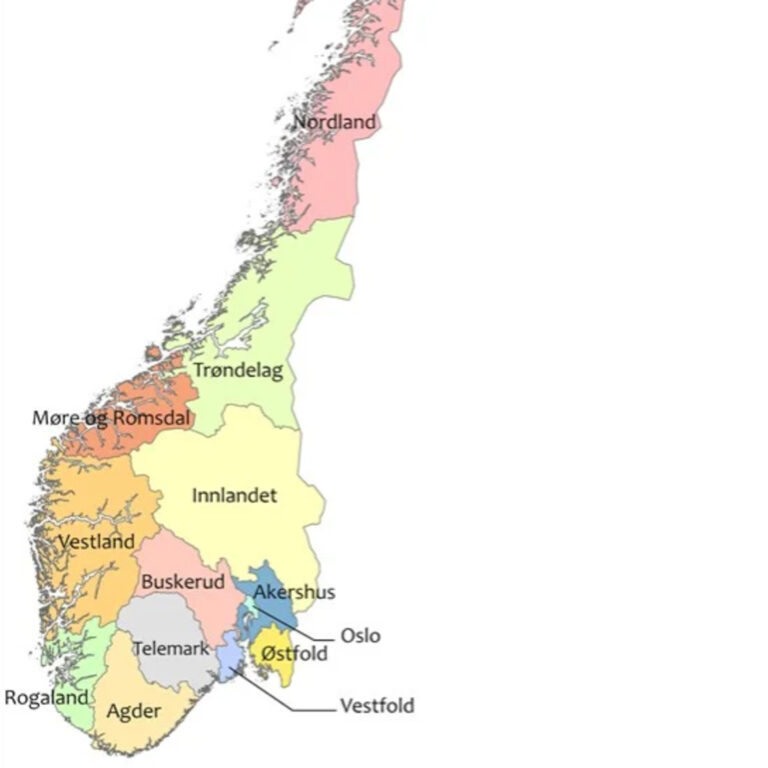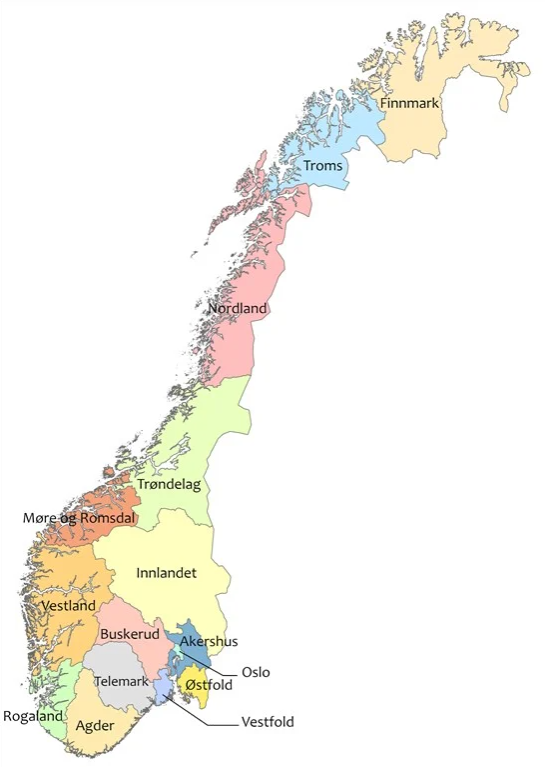02 januar 2024 | 13 minutt

Norsk for Beginners is a podcast aimed at beginners of Norwegian (A1-A2). The episodes are structured in two parts: One Norwegian speaking part and the second in English, explaining the Norwegian part and examining some Norwegian vocabulary used in the episode. I speak Norwegian in a clear, slow and deliberate manner, perfect for beginners. Get some listening practice by listening to “Norsk for Beginners”!
Email: Laernorsknaa@gmail.com
Transcript: https://laernorsknaa.com/8-1-the-regions-of-norway-an-overview/
Support me here –>
Patreon: https://www.patreon.com/laernorsknaa
Donasjon (Paypal): Doner (paypal.com)
For more content to learn Norwegian –>
YouTube: https://www.youtube.com/channel/UCxdRJ5lW2QlUNRfff-ZoE-A
In this season of the podcast, we will look at all the regions of Norway. We will look at all the 15 regions of Norway as of 2024 and look more at their geography, economy, and history. This is a great way to better understand the country. Each region will get their own episode, so that this season will have 17 episodes in total: One introduction episode (this one), one episode for each of the 15 regions, and a bonus episode for Svalbard. In this episode, we will take a broader look at the regions of Norway.

Episode’s Transcript
In this season of the podcast, we will look at all the regions of Norway. We will look at all the 15 regions of Norway as of 2024 and look more at their geography, economy, and history. This is a great way to better understand the country. Each region will get their own episode, so that this season will have 17 episodes in total: One introduction episode (this one), one episode for each of the 15 regions, and a bonus episode for Svalbard. In this episode, we will take a broader look at the regions of Norway.
Norske fylker
På norsk kaller vi regionene våre for fylker. Dette er geografiske, administrative og politiske enheter. Det vil si at vi har politikere på fylkesnivå. Videregående skole er organisert og finansiert på fylkesnivå. Hvert fylke har ansvar for transport innenfor sine grenser. Det vil for eksempel si at fylket Rogaland har ansvar for buss, tog og båt innenfor Rogaland sine grenser.
Ordet “fylke” kommer fra det norrøne “fylki” som betyr “folk”. Fylke er et gammelt ,svært gammelt ord for regionene våre i Norge. Den første dokumenterte bruken av ordet “fylke” for en region i Norge var i vikingtida på 800-tallet. På 800-tallet var dette små kongeriker og det var 30 fylker totalt i Norge. Noen av dem er fremdeles fylker i Norge som for eksempel Rogaland og Agder.
Ordet “fylke” har ikke bestandig blitt brukt i Norge for regionene våre. I 1308 ble ordet “fylke” endret til “syssel”. I 1660 under Danmark ble ordet igjen endret til “amt”. Navnet ble ikke endret tilbake til “fylke” før i 1918. Dette var for å ta tilbake det gamle, tradisjonelle norske ordet.
Selv om antall fylker har variert i historien, er det noen hovedtrekk i hvor fylkesgrensene går og har gått. Fylkene våre er sterkt basert på historien vår. Å tilhøre et fylke er også en viktig del av folks identitet. Jeg kommer for eksempel fra Rogaland. Jeg kan si at jeg er en “rogalending”. Å komme fra Rogaland er altså en del av min identitet.
Fra 1919 var det 20 fylker i Norge. Dette tallet har siden gått ned. I 1972 ble byfylke Bergen slått sammen med Hordaland. Vi hadde 19 fylker i Norge helt fram til 2018. Da ble Nord-Trøndelag og Sør-Trøndelag i Midt-Norge slått sammen til Trøndelag. I 2020 kom en stor reform. Da ble 18 fylker til 11 fylker. Akershus, Buskerud og Østfold på Østlandet ble slått sammen til Viken. Hedmark og Oppland på Nordøstlandet ble slått sammen til Innlandet. Vestfold og Telemark ble slått sammen til “Vestfold og Telemark”. Hordaland og Sogn og Fjordane på Vestlandet ble slått sammen til Vestland. Troms og Finnmark ble slått sammen til “Troms og Finnmark”. Vest-Agder og Aust-Agder på Sørlandet ble slått sammen til Agder.
Mange av disse nye fylkene var svært upopulære. Som sagt er det mange som er sterkt knytta til fylket sitt. Mange har en sterk identitet til fylket sitt. Den nye regjeringa lova at de ville splitte de mest upopulære inndelingene. Dette vil si at vi fra 1. januar 2024 vil få 15 fylker. Viken kommer til å splittes opp i Akershus, Østfold og Buskerud. “Vestfold og Telemark” vil igjen bli fylket Vestfold og fylket Telemark. “Troms og Finnmark” blir fylket Troms og fylket Finnmark.
Til slutt vil jeg gi dere en oversikt over fylkene i Norge i 2024 basert på landsdeler. Landsdelene i Norge er Nord-Norge, Midt-Norge, Østlandet, Vestlandet og Sørlandet. Vi begynner i nord.
Nord-Norge består av:
- Finnmark
- Troms
- Nordland
Midt-Norge består av:
- Trøndelag
Vestlandet består av:
- Møre og Romsdal
- Vestland
- Rogaland
Østlandet består av:
- Innlandet
- Akershus
- Buskerud
- Telemark
- Østfold
- Vestfold
- Oslo
Sørlandet består av:
- Agder.
Norwegian Regions
In Norwegian, we refer to our regions as “fylker.” These are geographical, administrative, and political units. Upper Secondary education is organized and funded at the county level. Each county is responsible for transportation within its borders. For example, the county of Rogaland is responsible for buses, trains, and boats within the boundaries of the county.
The word “fylke” comes from the Old Norse “fylki,” which means “people.” “Fylke” is an ancient word for our regions in Norway. The first documented use of the word “fylke” for a region in Norway was during the Viking Age in the 800s. In the 800s, these were small kingdoms, and there were a total of 30 counties in Norway. Some of them are still counties such as Rogaland and Agder.
The term “fylke” has not always been used in Norway for our regions. In 1308, the word “fylke” was changed to “syssel.” In 1660, under Danish rule, the word was changed again to “amt.” The name was not changed back to “fylke” until 1918, to reclaim the old, traditional Norwegian word.
Although the number of counties has varied in history, there are some main features of where the county boundaries are and have been. Our counties are strongly based on our history. Belonging to a county is also an important part of people’s identity. For example, I come from Rogaland and I say that I am a “rogalending.” Coming from Rogaland is thus a part of my identity.
From 1919, there were 20 counties in Norway. This number has since decreased. In 1972, the city-county Bergen was merged with Hordaland. We had 19 counties in Norway until 2018. Then, Nord-Trøndelag and Sør-Trøndelag in Mid-Norway were merged into Trøndelag. In 2020, a major reform occurred. 18 counties became 11 counties. Akershus, Buskerud, and Østfold in the east were merged into Viken. Hedmark and Oppland in the northeast were merged into Innlandet. Vestfold and Telemark were merged into “Vestfold og Telemark.” Hordaland and Sogn og Fjordane in the west were merged into Vestland. Troms and Finnmark were merged into “Troms og Finnmark.” Vest-Agder and Aust-Agder in the south were merged into Agder.
Many of these new counties were very unpopular. As mentioned, many people have a strong connection to their county. The new government promised to split the most unpopular new counties. This means that from January 1, 2024, we will have 15 counties. Viken will be split into Akershus, Østfold, and Buskerud. “Vestfold og Telemark” will again become Vestfold and Telemark. “Troms og Finnmark” will become Troms and Finnmark.
Finally, I will give you an overview of the counties in Norway in 2024 based on Northern Norway, Mid-Norway, Eastern Norway, Western Norway, and Southern Norway. We start in the north.
Northern Norway consists of:
- Finnmark
- Troms
- Nordland
Mid-Norway consists of:
- Trøndelag
Western Norway consists of:
- Møre og Romsdal
- Vestland
- Rogaland
Eastern Norway consists of:
- Innlandet
- Akershus
- Buskerud
- Telemark
- Østfold
- Vestfold
- Oslo
Southern Norway consists of:
- Agder
Vocabulary
| Norsk | Engelsk | Eksempelsetninger på norsk |
| Ansvar | Responsibility | Han tok ansvar for feilen og rettet den opp. |
| Innenfor | Within | Biblioteket ligger innenfor skolens område. |
| Grenser | Borders | Landet har klare grenser som er godt definert. |
| Kongeriker | Kingdoms | Middelalderen var preget av ulike kongeriker. |
| Bestandig | Constant | Han var bestandig glad og klaget aldri. |
| Antall | Number | Antallet studenter økte dramatisk i løpet av året. |
| Hovedtrekk | Main features | Hovedtrekkene i rapporten ble presentert på møtet. |
| Tilhøre | Belong to | Denne boken tilhører bibliotekets samling. |
| Slått sammen med | Merged with | To selskaper ble slått sammen med suksess. |
| Upopulære | Unpopular | Beslutningen var upopulær blant de ansatte. |
| Splitte | Divide | Konflikten truet med å splitte samfunnet. |
| Inndeling | Division | Inndelingen av arbeidsoppgaver var effektiv. |

I have started learning Norwegian some time ago. Even tough I never went to this country before, it is a place that very intrigued me in the last few years.
As a French speaker coming from Canada, I have a great feeling of attachment to the North, and since I have discovered in my genealogical tree that I do have some Scandinavian ancestry starting from about the 1000’s from the age of William the Conqueror (yes it is far away I know, but still part of my blood), who is a descendant from Rollo, but also from other important Norse figures, I wanted to learn a new culture, along with its language of course.
In any case, I found this podcast very interesting, and your method of teaching is just perfect in order for us to follow along and comprehend while also progressing in our understanding of the Norwegian language.
Tusen takk!
(PS: You might never read this message since there is not much people already commenting as I seem to be seeing, but I still wanted to reach out to at least thank you for what you do. 🙂 )
Thank you for taking time to share your history. I love your reason for getting more involved in the language and culture, and I wish you the best of luck on your journey.
(PS: I read all the comments and messages I get and I appreciate them a lot 🙂 )